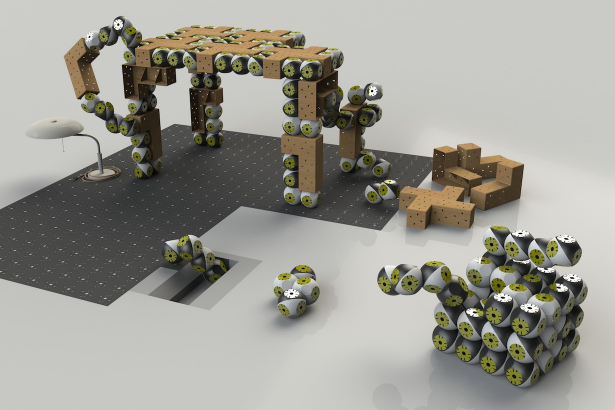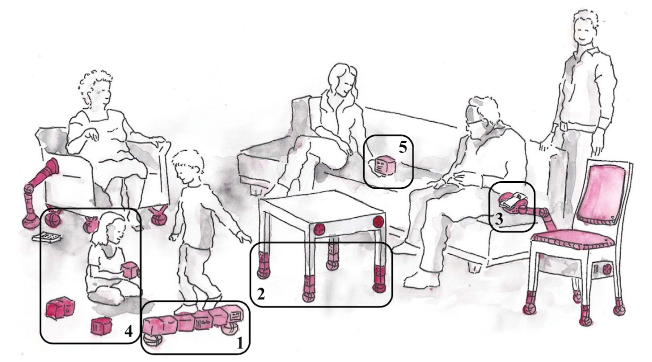Fan Cheng The modular robot roombot comes out and can be turned into a table, chair and bed
Published on:2020-04-21
Over the past decade, roombots of EPFL has been doing modular research and development to make it the only furniture you need. These small square and circular robot modules can move and lock each other, and can synthesize chairs, tables or anything else you want. Any furniture will be created (or disbanded) dynamically, and roombots will be intelligently combined and stacked as needed.

Roombots is a very attractive idea, especially for people with small houses. For example, I have a table and four chairs. If I want to have more friends for dinner, theyd better bring their own chairs because I dont have a chair for them. However, if my furniture is roombots, my bed can decompose itself when needed to make more chairs. Alternatively, I can store a bunch of extra roombot modules in the closet and take them out when needed to form what I need.

In a new paper by roomrooms, researchers at the EPFL biorobotics laboratory, led by Professor Auke ijspeert, showed some practical (under study) case combination transformations, and also tried how roombots interact with existing furniture to give it new functions - being able to follow your chair, leave your chair, and a table that can pick up items from the floor.
This video shows a combination of system level autonomous behavior (for complex coordination tasks) and manual control to demonstrate specific hardware functions or new functions that are still in the proof of concept stage. For example, the video of chair arrangement is basically autonomous (except a little manual operation). Users can also use Kinect installed on the ceiling and external computer for tracking, avoidance and hand tracking. Roombots used to move the tea table are manually controlled, and bottle opening is a combination of user control and sports source language.
In the past five years, roombots itself has made great progress. The internal structure has been redesigned and equipped with a new low recoil gearbox, new connecting mechanism and new electronic equipment. The gripper system, LEDs, spotlights and proximity sensors are also new designs. Most importantly, the number of active roombot modules has increased from just two (the minimum number you need to experiment with the basic functions of docking, undocking and moving) to 13, enough to do more interesting things.

The expected functions of roombots: (1) a group of roombots modules reconfigure themselves into the shape of toys; (2) Mobile furniture, in which the roombot module has been used to enhance the existing furniture to enable it to move in the living space; (3) Furniture can assist in object manipulation for simple tasks such as picking up and holding a remote control; (4) Interactive furniture, allowing users to work with upgraded furniture; (5) Easy to use user interface for viewing the current status of the robot system.
Although roombots (and other modular robots) have many potential advantages, including relatively low single module cost, easy replacement of faulty modules and versatility, they are much more difficult in design and programming than other robots, and some robots specifically used for a certain function must provide better special performance than modular robots. If it is a case that requires adaptability, do not know what will happen, or do not know the task, modular robots such as roombots are very worthy of consideration.

Roombots is a very attractive idea, especially for people with small houses. For example, I have a table and four chairs. If I want to have more friends for dinner, theyd better bring their own chairs because I dont have a chair for them. However, if my furniture is roombots, my bed can decompose itself when needed to make more chairs. Alternatively, I can store a bunch of extra roombot modules in the closet and take them out when needed to form what I need.

In a new paper by roomrooms, researchers at the EPFL biorobotics laboratory, led by Professor Auke ijspeert, showed some practical (under study) case combination transformations, and also tried how roombots interact with existing furniture to give it new functions - being able to follow your chair, leave your chair, and a table that can pick up items from the floor.
This video shows a combination of system level autonomous behavior (for complex coordination tasks) and manual control to demonstrate specific hardware functions or new functions that are still in the proof of concept stage. For example, the video of chair arrangement is basically autonomous (except a little manual operation). Users can also use Kinect installed on the ceiling and external computer for tracking, avoidance and hand tracking. Roombots used to move the tea table are manually controlled, and bottle opening is a combination of user control and sports source language.
In the past five years, roombots itself has made great progress. The internal structure has been redesigned and equipped with a new low recoil gearbox, new connecting mechanism and new electronic equipment. The gripper system, LEDs, spotlights and proximity sensors are also new designs. Most importantly, the number of active roombot modules has increased from just two (the minimum number you need to experiment with the basic functions of docking, undocking and moving) to 13, enough to do more interesting things.

The expected functions of roombots: (1) a group of roombots modules reconfigure themselves into the shape of toys; (2) Mobile furniture, in which the roombot module has been used to enhance the existing furniture to enable it to move in the living space; (3) Furniture can assist in object manipulation for simple tasks such as picking up and holding a remote control; (4) Interactive furniture, allowing users to work with upgraded furniture; (5) Easy to use user interface for viewing the current status of the robot system.
Although roombots (and other modular robots) have many potential advantages, including relatively low single module cost, easy replacement of faulty modules and versatility, they are much more difficult in design and programming than other robots, and some robots specifically used for a certain function must provide better special performance than modular robots. If it is a case that requires adaptability, do not know what will happen, or do not know the task, modular robots such as roombots are very worthy of consideration.

